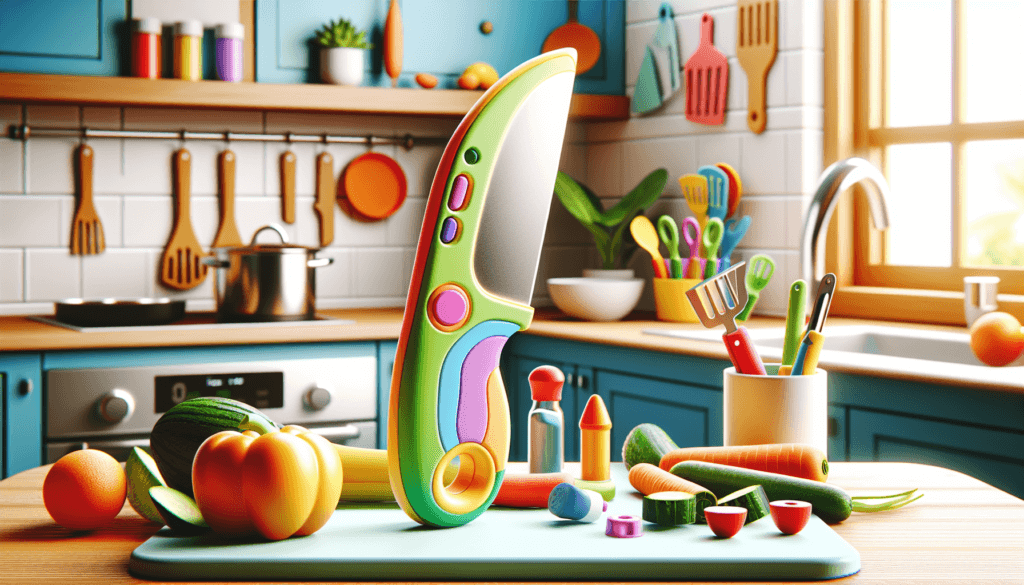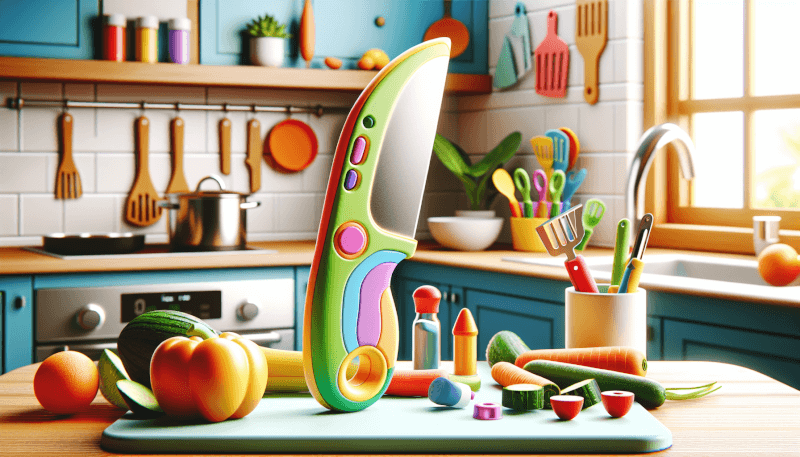Are you a parent or caretaker who wants to encourage your child’s interest in cooking, but worry about their safety in the kitchen? Look no further! In this article, we will explore the top-notch, child-friendly kitchen tools that will put your mind at ease while your little one whips up their culinary masterpieces. From specially designed knives to heat-resistant utensils, we have got you covered. Let’s ensure a safe and enjoyable cooking experience for both you and your child!

Choosing the Right Kitchen Tools
When it comes to cooking with kids, safety should always be the top priority. By choosing the right kitchen tools, you can ensure that your child can actively participate in the cooking process while minimizing the risk of accidents or injuries. Here are some factors to consider when selecting kitchen tools for kids.
Consider Age-appropriate Tools
One of the first things to consider when choosing kitchen tools for your child is their age and developmental stage. Younger children may benefit from using tools specifically designed for their smaller hands. Look for kitchen tools that are labeled as age-appropriate, as they will likely have features that make them easier and safer for kids to use.
Look for Non-slip Handles
Another important feature to consider is the handle of the kitchen tools. Look for tools with non-slip handles that provide a secure grip for your child. This will help prevent accidents such as the tool slipping out of their hands and potentially causing harm. Non-slip handles can be especially important when working with wet or greasy ingredients.
Prioritize Tools with Rounded Edges
Sharp edges pose a potential risk for cuts and injuries, especially for younger children who may not have developed proper knife handling skills yet. Opt for kitchen tools with rounded edges to reduce the risk of accidents. This is particularly important for tools like spatulas or scrapers that children may inadvertently swing or drop.
Opt for Lightweight and Easy-to-Grip Tools
In addition to non-slip handles, lightweight and easy-to-grip tools can provide added safety for kids in the kitchen. Heavy tools can be difficult for children to handle, increasing the risk of accidents. Look for tools made from lightweight materials such as plastic or silicone, as they are easier for children to control.
Knife Skills for Kids
Teaching kids how to properly handle knives is an essential kitchen skill. By focusing on knife safety and providing appropriate tools, you can help your child develop important culinary skills while minimizing the risk of accidents.
Teach Proper Knife Handling
Before introducing your child to a knife, it is crucial to teach them the proper way to hold and handle it. Start by demonstrating the correct grip and posture, emphasizing the importance of keeping fingers away from the blade. Teach them how to use a knife in a controlled and deliberate manner, avoiding any unnecessary movements or distractions.
Choose a Child-Friendly Knife
When it comes to selecting a knife for your child, it’s important to prioritize safety features. Look for knives that are specifically designed for children, with features such as rounded tips and finger guards. These features help reduce the risk of accidental injuries while allowing your child to develop their cutting skills.
Supervise and Guide their Knife Skills
Even with proper knife handling and child-friendly knives, it is crucial to supervise your child when they are using a knife. Provide guidance and assistance as needed, ensuring they are using the knife correctly and safely. As their skills improve, gradually give them more independence, but always ensure that they are using the knife in a safe and responsible manner.
Measuring and Mixing Tools
Involving kids in measuring and mixing ingredients can be a fun and educational experience. It not only teaches them about quantities and ratios but also improves their motor skills and coordination. To ensure their safety, consider the following factors when selecting measuring and mixing tools for kids.
Use Measuring Cups and Spoons with Clear Markings
When it comes to measuring ingredients, clear markings on measuring cups and spoons are essential. Look for tools with bold and easy-to-read measurements to avoid any confusion or errors. Using tools with clear markings will help your child accurately measure ingredients and promote a more successful cooking experience.
Consider Mixing Tools with Non-slip Bases
Mixing bowls and utensils with non-slip bases can provide stability and prevent accidents in the kitchen. These tools stay in place while your child is stirring or mixing ingredients, reducing the risk of spills or slips. Additionally, non-slip bases can help your child maintain better control over the mixing process.
Avoid Glass Mixing Bowls for Younger Children
While glass mixing bowls may be durable, they also pose a risk of breaking and causing injuries. For younger children who may have less control and awareness, it’s best to avoid glass bowls and opt for safer alternatives such as plastic or stainless steel. These materials are less likely to shatter if accidentally dropped.

Cooking Utensils for Kids
Cooking utensils play a vital role in the kitchen, and selecting the right ones for kids can make their culinary experience safer and more enjoyable. Consider the following factors when choosing utensils for your child.
Select Utensils with Heat-resistant Handles
When cooking, utensils can heat up quickly, posing a burn risk for children. Look for utensils with heat-resistant handles to minimize the risk of burns or discomfort. Silicone or wooden handles are excellent options as they remain cool to the touch even when exposed to heat.
Choose Silicone or Nylon Utensils
Utensils made from silicone or nylon are popular choices when it comes to kitchen tools for kids. These materials are lightweight, easy to grip, and safe to use on non-stick cookware. Additionally, silicone and nylon utensils are less likely to cause damage to pots, pans, or other surfaces, making them a practical choice for young cooks.
Avoid Metal Utensils for Young Children
While metal utensils are often used in the kitchen, they may not be the best option for young children. Metal utensils can be heavy and potentially cause injury if mishandled. Additionally, metal utensils can scratch or damage non-stick coatings on cookware. It’s best to avoid metal utensils until your child is more experienced and can handle them safely.
Electrical Appliances for Kids
Introducing electrical appliances to your child’s cooking repertoire can open up a whole new world of culinary possibilities. However, it’s essential to choose appliances that are designed with safety in mind and to closely supervise their usage.
Consider Kid-friendly Electrical Appliances
When selecting electrical appliances for kids, consider options specifically designed for their use. These appliances often feature safety enhancements such as extra guards, automatic shut-off mechanisms, and simplified controls. Kid-friendly appliances are designed to minimize risks while allowing children to explore and enjoy the cooking process.
Ensure Proper Safety Features
Regardless of the appliance you choose, ensure that it has proper safety features in place. Look for appliances with safety locks, non-slip bases, and easy-to-use controls. It’s also important to teach your child about the potential hazards associated with electrical appliances and how to use them safely.
Supervise Kids’ Usage of Electrical Appliances
Supervision is crucial when kids are using electrical appliances. While kid-friendly appliances are designed to be safe, accidents can still occur. Always be present and attentive when your child is using an electrical appliance, ensuring they are following proper safety protocols and using the appliance correctly.
Safe Cooking Surfaces
The cooking surface you choose can significantly impact your child’s safety in the kitchen. Consider the following factors when selecting cooking surfaces for young chefs.
Use Induction or Ceramic Cooktops
Induction or ceramic cooktops are generally safer options when cooking with kids. These surfaces remain cool to the touch and heat up only when the appropriate cookware is placed on them. This feature reduces the risk of accidental burns from coming into contact with a hot stovetop.
Avoid Gas Stoves for Young Children
Gas stoves may pose additional risks for young children due to open flames and potential gas leaks. Until your child is old enough to understand the dangers associated with gas stoves and can safely manipulate the controls, it’s best to avoid using gas stoves for their cooking activities.
Keep Hot Pots and Pans Out of Reach
Preventing burns and spills is essential for kitchen safety. Ensure that hot pots and pans are placed on the back burners of the stove, where they are less likely to be accidentally grabbed or knocked over by curious little hands. Additionally, make sure that pot and pan handles are turned inward to avoid any accidental spills or tips.
Oven Safety Measures
Ovens can be intimidating for kids due to the high temperatures involved. However, with the right safety measures in place, kids can safely learn how to use ovens and contribute to the cooking process.
Teach Kids about Oven Safety
Before allowing your child to use the oven, it is crucial to educate them about oven safety. Explain the potential dangers associated with high temperatures, emphasizing the importance of never touching the oven when it’s in use and never inserting their hands or any objects into the oven.
Use Oven Mitts and Heat-resistant Gloves
To protect your child’s hands from burns, it’s important to provide them with oven mitts or heat-resistant gloves. Teach them how to properly use these protective items and emphasize the importance of wearing them when handling hot pots, pans, or dishes from the oven.
Supervise Kids when Using the Oven
No matter how well your child understands oven safety, it is still crucial to supervise them when they are using the oven. Stay close by, providing guidance and assistance as needed. This way, you can ensure that your child is using the oven safely and prevent any potential accidents.
Avoiding Hazards in the Kitchen
In addition to selecting the right tools and equipment, it’s important to create a safe environment in the kitchen. By being mindful of potential hazards, you can further enhance your child’s safety.
Keep Knives and Sharp Objects Stored Safely
Sharp knives and other cutting utensils should be stored safely and out of reach when not in use. Use knife blocks, magnetic strips, or locked drawers to ensure that sharp objects are securely stored and away from children’s access. By doing so, you minimize the risk of accidental cuts or injuries.
Secure Pot and Pan Handles
Pot and pan handles that stick out from the stovetop can easily be bumped or grabbed by curious children. Make sure to turn handles inward while cooking to prevent accidental spills or tip-overs. Additionally, use back burners whenever possible to keep handles out of reach of little ones.
Minimize Clutter and Potential Tripping Hazards
A cluttered kitchen can increase the risk of accidents and injuries. To create a safer environment for your child, keep the kitchen clean and organized. Avoid leaving items on the floor or countertops that could potentially cause trips or falls. By minimizing clutter, you provide a safer space for your child to move around and work in.
Teaching Proper Kitchen Safety
While selecting the right tools and equipment is essential, teaching your child proper kitchen safety is equally important. By instilling good habits and emphasizing safety rules, you can empower your child to cook confidently and responsibly.
Educate Kids on Basic Kitchen Safety Rules
Teach your child basic kitchen safety rules, such as washing hands before and after handling food, using caution when working with hot surfaces, and wearing appropriate protective gear. Make sure they understand the importance of these rules and regularly reinforce them to ensure their safety in the kitchen.
Demonstrate Safe Handling Techniques
Actions speak louder than words, so take the time to demonstrate safe handling techniques to your child. Show them how to properly handle tools, cut ingredients, and operate appliances. By visually demonstrating these techniques, you help your child better understand and absorb the best practices for kitchen safety.
Encourage Communication and Supervision
Encourage your child to communicate with you while in the kitchen and ask for help or clarification when needed. Additionally, always supervise your child’s activities in the kitchen, providing guidance and assistance as necessary. By maintaining open lines of communication and ensuring constant supervision, you can address any potential safety concerns and prevent accidents from occurring.
Bonus Tips and Considerations
Beyond the specific areas highlighted above, the following bonus tips and considerations can help enhance your child’s kitchen safety:
Regularly Inspect and Maintain Kitchen Tools
Regularly inspect kitchen tools for any signs of wear or damage. Replace any tools that are no longer in good condition to ensure your child’s safety while cooking. Additionally, clean and maintain the tools according to the manufacturer’s instructions to prolong their lifespan and keep them safe for use.
Encourage Hand Washing Before and After Use
Hand hygiene is crucial in the kitchen to prevent the spread of germs and foodborne illnesses. Encourage your child to wash their hands thoroughly with soap and water before and after handling food or using kitchen tools. By instilling this habit, you promote good hygiene and minimize the risk of contamination.
Promote a Positive and Fun Cooking Experience
Finally, remember to make the cooking experience enjoyable for your child. Instill a positive and fun environment in the kitchen by creating opportunities for them to explore their creativity and develop culinary skills. By fostering a love for cooking, your child will be more motivated to learn and adhere to safety practices in the kitchen.
In conclusion, choosing the right kitchen tools and following proper safety measures are key to ensuring a safe cooking experience for kids. By considering age-appropriate tools, prioritizing safety features, and supervising their activities, you can nurture your child’s culinary skills while minimizing the risk of accidents or injuries. With the right tools, guidance, and a focus on safety, you can create a positive and enjoyable cooking environment for your child.


